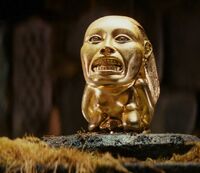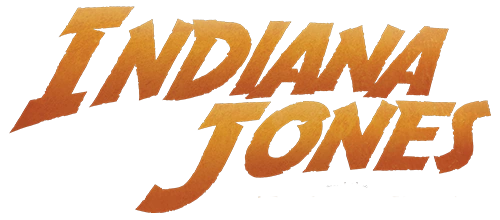- "The beliefs and superstitions of an entire culture, all wrapped up in a 2000-year-old, six-inch lump of gold!"
- ―Indiana Jones[src]
The Chachapoyan Fertility Idol, also known as the Idol of the Chachapoyan Warriors (shortened to Idol of the Warriors), Golden Idol,[4] or the misnomer Idol of the Incas, was a six-inch tall, solid gold representation of the Chachapoyan goddess of fertility known to the Inca as Pachamama and archaeologist Indiana Jones noted that it bore a strong resemblance to Aztec deity Tlazolteotl.
The deceptively light artifact was hidden by the tribe's priests in a temple deep within the jungles of Peru. Braving the temple's deadly traps to stare into the idol's eyes became a rite of passage for young Chachapoyan warriors, its exact weight precisely counterbalancing the trigger of an ancient self-destruct system.
Thanks to a combination of protections around the idol, the seclusion of the temple itself, and the lethally territorial nature of the Hovitos who came to inhabit the area, the Chachapoyan Fertility Idol remained undisturbed for around two thousand years until the turn of the 20th century when word of the site's unspoiled reputation began to gain traction.
History[]
The Chachapoyan Fertility Idol was created by the Chachapoyans circa 64 BC,[2] around the same time the Temple of the Warriors was erected to house it.[1] The Chachapoyan priests hid the idol away inside the temple as part of a soldier's rite of passage, a test that involved a Chachapoyan warrior finding his way into the Temple, avoid the booby traps and claim the idol, so if he survived, he had proven his worth but if not, he had made a favor to his people by being weeded out thanks to his weakness.[5]

The idol in its temple.
Around the 19th century, an American explorer named McHenry discovered the House of Warriors while excavating what remained of the Chachapoyan city of Tec'na'al. The gathering hall was decorated with pictographs that contained directions of, as well as a crude map to, the Temple of the Chachapoyan Warriors. McHenry noted the images, but the ruins were later hit by an earthquake. His research, however, was eventually kept at the University of Chicago.[5]
In 1935, a Princeton University archaeologist named Forrestal went to the jungles of Chachapoyas, Peru while attempting to recover the fertility idol of Pachamama from the temple.[6] Working from McHenry's notes, Forrestal was ultimately able to find the temple despite part of the map being stolen by the local thieves Barranca and Satipo.[5] Unfortunately for him, Forrestal rushed into the ancient structure without checking if there were any booby traps and was killed by a spike trap.[7]
In 1936, on commission from the National Museum and working from Forrestal's notes, Indiana Jones managed to locate the temple and extract the statue. Barranca and Satipo accompanied him alongside several porters, but Barranca was chased away after an unsuccessful attempt on Jones' life and then killed by the Hovitos while Satipo remained with the archaeologist. Upon triggering the temple's self-destruct mechanisms by taking the idol, Jones was betrayed by Satipo, who took the idol and left him to die. However, Satipo met his own end on a spike trap and Jones escaped the temple with the idol. Once outside, the idol was stolen by rogue archaeologist René Emile Belloq, who sent the Hovitos to chase Jones while he left with the idol.[3] Belloq promptly unloaded the artifact in Marrakesh, where Jones later re-appropriated it from the shop of antiquities dealer Saad Hassim.[2]

Sallah and Indiana Jones flee Marrakesh with the idol.
The National Museum celebrated the idol's arrival with a lavish banquet at the Diamond's Eye nightclub in New York City. Among the guests was a band of angry Hovitos led by Xomec, alleged descendant of the Chachapoyans. Xomec swiped the idol from curator Marcus Brody and fled to the jungles of Brazil. Jones gave chase, and after defeating Xomec and his Nazi co-conspirator Ilsa Toht, once again reclaimed the idol for the museum.[2]
Behind the scenes[]
The Chachapoyan Fertility Idol is based on the Dumbarton Oaks birthing figure, part of the pre-Columbian collection at Dumbarton Oaks.[8] The artifact is thought to depict the Aztec goddess Tlazolteotl although its provenance is disputed.[9][10]
In Raiders of the Lost Ark, the original idea for the scenes with the Chachapoyan Fertility Idol was to have its eyes following Indiana Jones as he moved around the room. As such, one of the props built featured mechanical moving eyes. Evidence of this can still be seen in the archival footage on the film's DVD. Ultimately, the idea was abandoned though one shot remains in the final film -- the one where Indy is pouring sand out of the bag.[11]
Dialogue by René Emile Belloq during the Marhala Bar scenes which was dropped from the final cut of Raiders indicates that Belloq wasn't intended to get away with the idol, with Belloq revealing that he was lucky to escape with his own life because the Hovitos ultimately proved to be quite "narrow-minded" with regards to who the idol's owner was.[11] Though also present in Marvel Comics' comic book adaptation,[12] the absence of the line from the film itself allowed the artifact's story to continue in The Further Adventures of Indiana Jones by Marvel.[2]
During the early development of the fourth film, Frank Darabont's script Indiana Jones and the City of the Gods featured a drunk Indiana Jones stealing the Chachapoyan Fertility Idol from the National Museum after unfairly losing his job at his university. To steal it, Indy would have replicated the opening Raiders sequence by putting a Bag of Sand to prevent the alarm from going off, only to fail and the alarm alerting Agent McKimson.[13]
There were plans by Icons in the mid-1990s to create a Chachapoyan Fertility Idol prop replica for a proposed Indiana Jones-licensed product-line called The Treasures of Indiana Jones, so some concept art was made. However, Icons' plans ultimately didn't go ahead.[14]
In the game LEGO Indiana Jones: The Original Adventures, Indy extracts the statue and leaves the temple with Satipo. Once in the jungle, Belloq confronts Jones, and Indy tries to give him other things (first a diamond, a rubber duck, and then C-3PO's head, which is very similar to the Idol) but Belloq isn't fooled and takes the real deal.[15] Although the Peru sequence is omitted from the sequel, it appears that Indy extracted the Idol successfully as he gives it to Marcus Brody, having been chased by the giant rolling boulder from Peru to the United States.[16]
Appearances[]
- Raiders of the Lost Ark novel (First appearance)
- Raiders of the Lost Ark comic
- Raiders of the Lost Ark
- Indiana Jones' Greatest Adventures
- Indiana Jones: Traps and Snares
- Indiana Jones: The Search For Buried Treasure
 The Further Adventures of Indiana Jones – "The Gold Goddess: Xomec's Raiders"
The Further Adventures of Indiana Jones – "The Gold Goddess: Xomec's Raiders" The Further Adventures of Indiana Jones – "The Gold Goddess: Amazon Death-Ride!"
The Further Adventures of Indiana Jones – "The Gold Goddess: Amazon Death-Ride!"- Disney Magic Kingdoms (Ambiguously canonical appearance)
- Indiana Jones and the Infernal Machine (Mentioned only)
- Indiana Jones and the City of the Gods (Cancelled)
- Disney Emoji Blitz
Non-canonical appearances[]
Sources[]
 Raiders of the Lost Ark trading cards (Card: Removing the Idol)
Raiders of the Lost Ark trading cards (Card: Removing the Idol) Raiders of the Lost Ark trading cards (Card: The Collapsing Walls)
Raiders of the Lost Ark trading cards (Card: The Collapsing Walls) Raiders of the Lost Ark trading cards (Card: Chased... By A Boulder!)
Raiders of the Lost Ark trading cards (Card: Chased... By A Boulder!) Raiders of the Lost Ark trading cards (Card: Snagged by Belloq)
Raiders of the Lost Ark trading cards (Card: Snagged by Belloq)- The Golden Goddess
- Raiders of the Lost Ark Sourcebook
- From Star Wars To Indiana Jones - The Best of the Lucasfilm Archives
Raiders of the Lost Ark: Ready, set, switch on IndianaJones.com (backup link on Archive.org)
Belloq's Marshall College entry on IndianaJones.com (backup link on Archive.org)
Indiana Jones' Marshall College entry on IndianaJones.com (backup link on Archive.org)
Satipo's Marshall College entry on IndianaJones.com (backup link on Archive.org)
- Indiana Jones and the Emperor's Tomb: 1935 Journal
- The Lost Journal of Indiana Jones
- Indiana Jones: The Ultimate Guide
 Indiana Jones Heritage trading cards (Card: A Game of Chance)
Indiana Jones Heritage trading cards (Card: A Game of Chance)- Indiana Jones action figures (Pack: The Lost Wave)
- Indiana Jones World Map
 The Real Indiana Jones: Curiosity & Creativity on Lucasfilm.com (backup link on Archive.org)
The Real Indiana Jones: Curiosity & Creativity on Lucasfilm.com (backup link on Archive.org)
Notes and references[]
- ↑ 1.0 1.1 1.2 Raiders of the Lost Ark novel
- ↑ 2.0 2.1 2.2 2.3 2.4 2.5
 The Further Adventures of Indiana Jones – "The Gold Goddess"
The Further Adventures of Indiana Jones – "The Gold Goddess"
- ↑ 3.0 3.1 3.2 Raiders of the Lost Ark
- ↑
 Indiana Jones Heritage trading cards (Card: A Game of Chance)
Indiana Jones Heritage trading cards (Card: A Game of Chance)
- ↑ 5.0 5.1 5.2 Raiders of the Lost Ark Sourcebook
- ↑ Indiana Jones: The Ultimate Guide
- ↑ The Greatest Adventures of Indiana Jones
- ↑
 Celebrate the 40th Anniversary of Raiders of the Lost Ark with Exclusive Products on Lucasfilm.com (backup link on Archive.org)
Celebrate the 40th Anniversary of Raiders of the Lost Ark with Exclusive Products on Lucasfilm.com (backup link on Archive.org)
- ↑ Tlazolteotl (photo of Dumbarton Oaks idol). The Guardian. Guardian News and Media Limited (2009).
- ↑ The Birthing Figure in the Robert Woods Bliss Collection of Pre-Columbian Art at Dumbarton Oaks
- ↑ 11.0 11.1 The Complete Making of Indiana Jones
- ↑ Raiders of the Lost Ark comic
- ↑ Indiana Jones and the City of the Gods
- ↑ Icons GRAIL CUP prototype at THROW ME THE IDOL (Web archive)
- ↑ LEGO Indiana Jones: The Original Adventures
- ↑ LEGO Indiana Jones 2: The Adventure Continues
